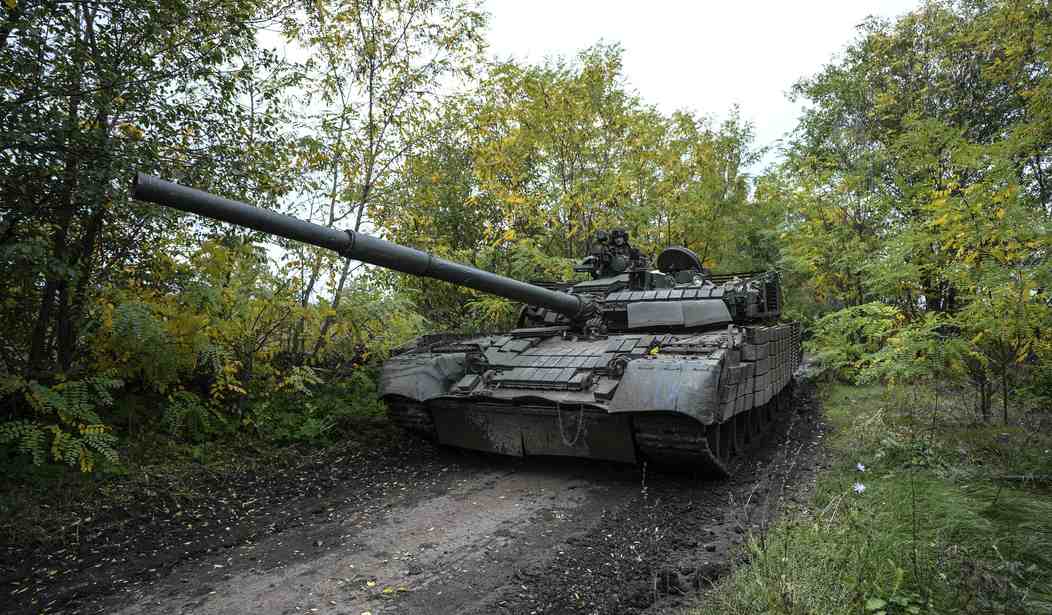Today marks 287 days or 41 weeks since Vladimir Putin’s rather inept army crossed the border into Ukraine. The rainy season — bezdorizhzhia in Ukrainian or rasputitsa in Russian — is coming to an end. Soon the ground will freeze, and military operations will be possible so long as the troops are equipped to contend with the cold.
Politico-Strategic Level
Volodymyr Zelensky is TIME’s Man of the Year

I don’t think this is much of a shock to anyone. Using TIME’s criteria of “the person or persons who most affected the news and our lives, for good or ill, and embodied what was important about the year,” it is hard to think of someone who has more dominated news coverage during 2023.
Sweden Militarizes Gotland
One of the side effects of Vladimir Putin’s military adventure in Ukraine is that NATO has expanded to include Finland and Sweden. As a result, both those nations are increasing their defense budgets and moving military units into previously unmilitarized places. One of those is the Swedish province of Gotland. Gotland is located in the Baltic Sea between Sweden and Latvia, controlling Russian Sea Lines of Communication and dominating the Russian enclave of Kaliningrad, homeport of the Russian Baltic Fleet.
Swedish RBS-15 coastal missile unit on Gotland. https://t.co/HfGQXmNLzR
— The Lookout (@The_Lookout_N) December 6, 2022
Expect the missile unit to be joined in the very near future by elements of the Swedish Air Force.
Training of the Ukrainian Army Continues
Russian social media is full of stories of Russian soldiers being hurriedly sent to the front — in one case, less than five days elapsed from a soldier being “mobilized” until they were captured — with inadequate equipment. If Russian society were capable of recognizing a scandal, this would be one. Here prominent television personality Vladimir Solovyov shows Russian soldiers who have made kneepads from plastic bottles (the whole clip is worth watching, this reference starts at about 1:35).
Meanwhile in Russia: top propagandist Vladimir Solovyov shows off the improvised knee pads made by the mobilized Russian men out of plastic bottles. Later on, Solovyov casually threatens the viewer who asks him to stop lying and deceiving people. pic.twitter.com/FNB3fAQIBu
— Julia Davis (@JuliaDavisNews) November 30, 2022
Ukrainian soldiers are trained in the UK and Germany. They are trained by professional soldiers for about five weeks before returning to Ukraine. When they finish training, they have uniforms and field gear.
Ukrainian recruits training in the UK are issued kit in preparation for their return to Ukraine where they will fight to free their nation.
As the temperature plummets, recruits are given cold weather clothing in addition to the regular kit.
#StandWithUkraine pic.twitter.com/CWqcGjA43y— Ministry of Defence 🇬🇧 (@DefenceHQ) December 4, 2022
Arms and Ammunition
The war in Ukraine is consuming ammunition, equipment, and men at a prodigious rate. My last update (Putin’s War, Week 40. Winter Is Coming, and It Is Looking Like Finland in 1939) included an item on Ukraine resuming artillery ammunition production.
The Department of Defense is responding to the increased demand for artillery ammunition by increasing production capacity. A significant chunk of our ability to produce ammunition of all types disappeared during the Base Realignment and Closure bacchanalia that attended the end of the Cold War. Ammunition plants were among the first things shut down or drastically scaled back.
BOOM! The U.S. Army is planning a ‘dramatic’ six-fold artillery shell production boost, its chief weapons buyer @DouglasBush said in exclusive interview at #RNDF2022, via @reporterjoe https://t.co/iJRGqgpTzF
— Joe Gould (@reporterjoe) December 5, 2022
Czech Arms Industry Steps Up
The Czechs are increasing production at one of their armament factories to refurbish and update the Russian tanks coming out of storage in former Warsaw Pact countries and those captured in Ukraine. It is also producing a weapon that would have been considered obsolete only a year ago. That is, an antiaircraft gun mounted on a light vehicle. These are proving their worth in combatting the drones that have become ubiquitous on the battlefield.
Czech Excalibur Army company restores and modernizes Т-72 tanks for Ukraine.
At the moment, work is underway on 90 tanks.
More details- https://t.co/R8RshA55BH pic.twitter.com/IdAIRTld6h— Special Kherson Cat 🐈🇺🇦 (@bayraktar_1love) December 3, 2022
87. Film in tweet 85 also adds: Another weapon made at the🇨🇿Excalibur plant that the UAF will receive are these AA guns on pickup trucks – at 1st glance a ZPU variant? Reportedly Czech activists are raising funds for 15 and so far have saved up for four. https://t.co/eH5VPpJzqT pic.twitter.com/IfmpUyhgbh
— Dan (@Danspiun) December 6, 2022
And we have more reporting on the Russian ammunition shortage that is just around the corner.
U.S. intel chief: Russia is using up ammo in Ukraine faster than it can replace it https://t.co/HbcAC7orgl
— Dan De Luce (@dandeluce) December 4, 2022
I have no doubt this report is true. The Russians are shooting artillery ammunition at a much higher rate than they can manufacture it. They are losing ammunition dumps just about every night to HIMARS. Anecdotally, artillery ammunition manufactured in the 1980s has been recovered on the battlefield. The question is, when does this manufacturing shortage become cold gun tubes? To date, I haven’t seen anything that comes close to giving a satisfactory answer.
The Iran-Russia Arms Axis has Growing Pains
I’ve posted several times on the strange relationship emerging between Iran and Russia. Russia is buying drones, particularly the Shahed-136 suicide drones (what kind would you expect the Iranians to produce?), from Iran. In addition, there have been talks of Russia buying Iranian short-range ballistic missiles. Iran is also supplying Russia with helmets and body armor. The relationship has developed to the point where there are rumors of a Russian production facility being set up to produce Iranian drones. This relationship has hit a snag.
Iranian-made suicide drones have nearly disappeared from the battlefield in the last few weeks. There could be a number of reasons for this. My top guess is that Russia has burned them faster than they can be imported from Iran. We also know that a significant percentage of the Iranian military trainers sent to Crimea have been killed, both by artillery attack and by direct action. This could have caused a gap in the tech transfer needed to teach the Russians how to service and operate the drones. A third possibility is that the Iranian drones don’t work all that well in a cold, wet climate. The latter is not as far-fetched as it might seem. Iran’s arms industry is under sanctions, limiting its customer base to pariah states. Its military isn’t an expeditionary force, so it makes sense for its domestic weapons to be tailored to its area of operations. Because of sanctions, it would make sense for manufacturing to cut as many corners as possible.
New Missile Attacks on Ukrainian Infrastructure
A new round of missile attacks hit Ukraine earlier in the week. These have been happening about weekly — they seem to hit Monday-Tuesday — for about two months. I suspect it reflects the target acquisition/planning/execution/battle damage assessment cycle. The missiles are fired mostly from Russian surface combatants in the Black Sea and by strategic bombers from a launch site over the Caspian Sea.
Russian cruise missiles flying over the Dnipropetrovsk region just minutes ago. pic.twitter.com/sUQ9JGeCfL
— Visegrád 24 (@visegrad24) December 5, 2022
#BREAKING: Russia Launches Another Massive #MissileAttack Against #Ukraine
Ukraine is under attack once again as #Russia launches the latest wave of missiles in a bid to cripple the country’s energy infrastructure.
Read more on our website. https://t.co/4AidD5iAAd
— KyivPost (@KyivPost) December 5, 2022
The Ukrainian antiaircraft network shoots down 80-90% of the weapons. Unfortunately, that means 10-20% get through, many hitting high-value, hard-to-replace infrastructure.
1/ Thanks to the recent help from the West, #Ukraine air defense is getting more effective. Today, during the 8th Russian mass missile strike, it shot down more than 60 out of more than 70 missiles fired, reports Ukr. Air Force. The sucess ratio grew up to about 90%. pic.twitter.com/aDbxzZAgUK
— Viktor Kovalenko (@MrKovalenko) December 5, 2022
As I’ve said before, striking civilian infrastructure simply to make life miserable for the civilian population is contrary to the law of warfare. But, in the words of some 18th-century French diplomat (there are various claimants to ownership), “It is worse than a crime, it is a blunder.” The US Army Air Force Strategic Bombing Survey conducted in Europe and the Far East after World War II showed that attacking the civilian population creates unity and a sense of purpose. In the end, Western air defense systems will defeat the Russian missile threat. Western manufacturers will replace the damaged or destroyed infrastructure components. What will live for generations is Ukrainian enmity against Russia and things associated with Russia.
Putin Visits the Kerch Strait Bridge
The successful Ukrainian attack on the Kerch Strait Bridge in early October is, along with the sinking of the Moskva (BREAKING. Russian Flagship Sinks While Being Towed to Port), one of the signs of Ukrainian fighting spirit and inventiveness (WATCH: Incredible Footage of Key Russian-Controlled Bridge in Crimea Being Destroyed).
Monday, Vladimir Putin made a photo op visit to check out the repairs underway on the bridge. In a German car.
Naturally putin is driving a German car… … … https://t.co/cWKvF70nqq
— Thomas C. Theiner (@noclador) December 5, 2022
Latvia Bans Russian Language TV Station
The Latvian government has banned a Russian-language television station from broadcasting within Latvia. The network called Dozhd, or Rain, was forced out of Russia last Spring and positions itself as a “moderate” Russian voice. It was banned after it violated Latvian broadcast laws three times.
Latvia cancels license of Russian TV Rain (Dozhd) over "threat to national security": details
Dozhd must stop broadcasting on 8 December. The decision was made after 3 violations, Latvia's media regulator NEPLP saidhttps://t.co/bMCzQsA7q7
— Euromaidan Press (@EuromaidanPress) December 6, 2022
Latvia has revoked Dozhd's broadcasting license. Harsh desicion made after three strikes. Map without Crimea, no Latvian subtitles and the "our boys are suffering scandal". Russian opposition could have admitted that the one must respect laws of Latvia. 👇
— Nika Melkozerova (@NikaMelkozerova) December 6, 2022
The last strike described here is not exactly correct. The announcer commiserated about the condition of Russian troops and encouraged listeners to mail clothing, etc., to them.
Meduza, another independent outlet I like, takes umbrage at the banning and says it plays into Moscow’s hands. This account, a Russian grad student in London, has a different perspective. You can read the whole thread at this link without visiting Twitter.
@tvrain positions itself as a liberal outlet broadcasting exclusively in russian. It was launched on April 27, 2010, by Natalya Sindeeva @sindeeva and Vera Krichevskaya @krichevskaya. The channel primarily focuses on political, economic, and cultural news and analyses. 2/
— Madi Kapparov (@MuKappa) December 4, 2022
Operational Level
For about the fourth week in a row, I’m going to dispense with maps unless they are necessary to accompany placenames. The frontlines are basically unchanged. Both sides have made small advances but nothing significant.
New Weapons
Polish S-125 “Newa” Air Defense System
This Westernized version of the Soviet-era SA-3 “Goa” surface-to-air missile has been shipped to Ukraine. It is effective from ground level to about 60,000 feet.
German RCH-155 Howitzer
An outgrowth of the formidable Panzerhaubitze 2000 or Pzh 2000 (see more details at US Artillery Delivered to Ukraine Is More Than Guns, It Is a Game-Winning Change From the Present), the RCH-155 can engage targets while on the move. It has a two-man crew and is a transitional system between conventional artillery and autonomous networked guns.
Prisoner Exchanges
Prisoner exchanges continue. We’ve become used to this kind of imagery as 50 or so Ukrainians are exchanged for a like number of Russians.
Ukrainian POWs exchanged today
📹https://t.co/7yWdA0mqmH pic.twitter.com/Fby0weIsx8
— Euromaidan Press (@EuromaidanPress) December 6, 2022
The Washington Post did a deeper dive into Ukrainian prisoners of war and had a grim story to tell. Give it a read.
The 60 prisoners of war arrived on Ukrainian soil Tuesday afternoon — free after the latest trade between Moscow and Kyiv, but still under strict rationing.
The nurses treating them at a hospital in northeast Ukraine were instructed to give each soldier no more than 300 milliliters of chicken soup, or about 20 tablespoons. Many were so malnourished during Russian captivity that they would be unable to digest more that, the hospital director said.
…
Although they are supposed to be protected by the Geneva Conventions, which require humane treatment, the prisoners’ physical condition — protruding shoulder blades and ribs, bandaged limbs, long scars — bore evidence of abuse from their months of imprisonment in addition to injuries from combat.
“Tasers, currents — they beat us with clubs; they beat us with sticks. I said goodbye to my life there more than once,” said Vitalii, whose surname and military unit The Washington Post is not identifying for security reasons.
“There were such beatings that I could not stand them,” Vitalii said. “My ribs were broken; my kidney was beaten off, it was lowered,” he said, adding that he urinated blood for 10 days with no medical attention after his kidneys were hurt.
Combat Operations
Russian Lancet Suicide Drone
Russian Lancet loitering munition strikes on Ukrainian AD assets, including a pair of hits on a P-18 Spoon Rest and 36D6 radar.
Hitting moving targets may prove to be more of a challenge, with additional misses against a 30N6 Flap Lid and 5P85D TEL from an S-300PS battery. pic.twitter.com/CZZxXEZF6d
— OSINTtechnical (@Osinttechnical) December 6, 2022
Translation:
P-18 “Spoon Rest”: Early warning radar.
36D6 “Tin Shield”: Surveillance radar for S-300 surface-to-air missile system.
30N6 “Flap Lid”: Target tracking radar for S-300 surface-to-air missile system.
5P85D TEL: Transporter Erector Launcher for S-300 surface-to-air missile system.
Gepard vs. Russian Missile
The Gepard is a tracked, antiaircraft gun system with twin 35mm automatic cannon aimed by radar. I previewed it in Putin’s War, Week 19. Political Uncertainty, Lots of New Weapons, and a Replay of the Western Front. It has become the go-to weapon for stopping Russian drones near the front lines as it is accurate, and the cannon rounds are much more cost-effective than $250K missiles.
This is a video of the Gepard in action.
Our Heroes shooting down a Russian cruise missile with a German Gepard, an anti-aircraft self-propelled gun.
Danke schön for them! They have proven their effectiveness! More Gepards will equal more protection for Ukrainian civilians and infrastructure! pic.twitter.com/8d8QXKvYNT
— Anton Gerashchenko (@Gerashchenko_en) December 5, 2022
Kharkiv
Front lines remain unchanged.
Donbas
The struggle around Bakhmut and related towns continues. There is a lot of shooting…and dying…but nothing to show for it. The only notable activity was the assassination of Maria Pirogova, a member of the quisling Donetsk People’s Republic parliament.
Oof 🥶🫢 https://t.co/UXwiHAvThd pic.twitter.com/q4A1N3m57N
— NOËL 🇪🇺 🇺🇦 (@NOELreports) December 7, 2022
Zaporizhzhia
The front lines in Zaporizhzhia remained unchanged. There was an assassination attempt on the Russian-appointed head of the Melitopol government.
Nikolai Volyk, deputy head of the occupied city of Melitopol in southern Ukraine, was leaving his home when an improvised explosive device detonated. https://t.co/Rmx6Fyh4EI
— Newsweek (@Newsweek) December 7, 2022
Volyk survived.
What’s Next
As I’ve said for the last month, the weather has brought combat operations to a halt due to mud. The mud is freezing. Ukraine is receiving a regular influx of men trained to NATO standards and equipped to fight in the cold. I don’t think the troops the Russians have rushed to the front can make the same claim. I would look for another Ukrainian offensive to kick off early in the New Year. My prediction is it will most likely come in Zaporizhzhia and will be focused on Melitopol.













Join the conversation as a VIP Member